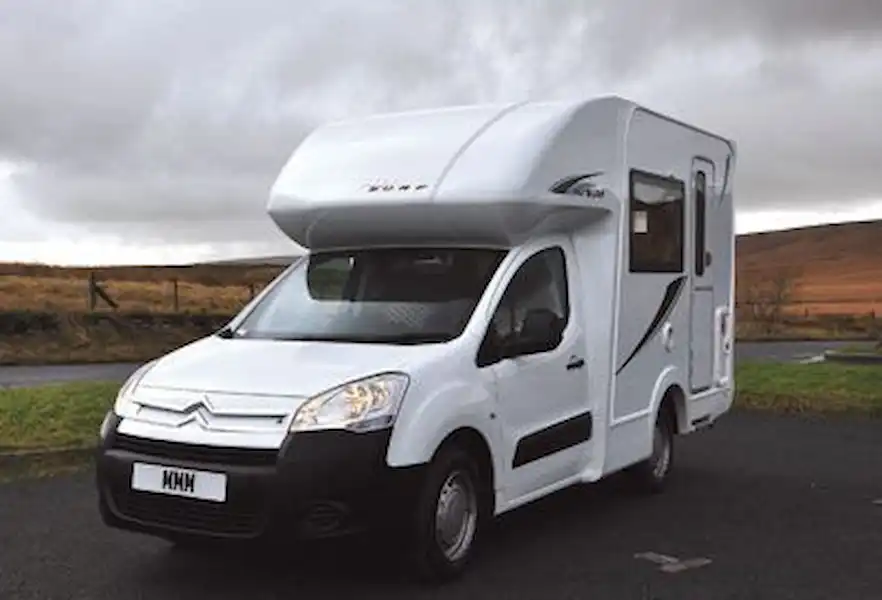Featured in this review
Nu Venture Motorhomes Nu Surf Side
| Model Year | 2012 |
| Class | Overcab Coachbuilt |
| Base Vehicle | Citroën Dispatch |
| Price From (£) | 30,650 |
| Engine Size | 1.6TD |
| Maximum Weight (kg) | 2,240 |
Romahome R20 Hi
| Model Year | 2012 |
| Class | Low Profile |
| Base Vehicle | Citroën Berlingo |
| Price From (£) | 30,995 |
| Engine Size | 1.6TD |
| Maximum Weight (kg) | 2,240 |
Full review
Romahome and Nu Venture have both made bijou Citroën-based motorhomes for over 20 years. Both use larger Citroën base vehicles, but major on the little Berlingo, and each has an enviable reputation and loyal clientele.The Nu Surf and New R20 have remarkably low prices, starting around £31,000 on the road and either is handy enough to serve as a sole vehicle, especially the R20 with its optional rear travel seats.
Romahomes have glossy, curvaceous GRP bodies, benefiting from a 10-year water ingress warranty. The habitation door, as is traditional, is in the rear panel. It has two windows and its generous width and low step height make for easy access. The tested ’van had a fixed overcab, but a Lo version – with rising roof and external height of below two-metres – is promised.
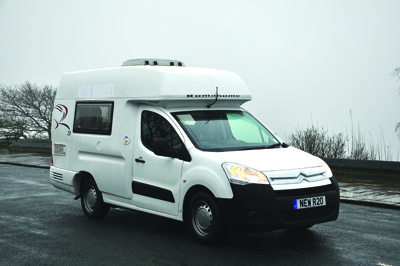
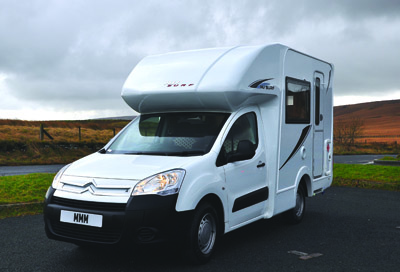
Inside, there’s a cooker and cupboards on the right, with a sink and further cupboards on the left – all finished in gleaming white GRP. Beyond, and up a substantial step, the lounge has settees to the offside and across the width, behind the much lower cab. On the nearside there’s a dinette with a wall-mounted detachable table. The test vehicle was fitted with two forward-facing travel seats with three-point seatbelts (on the offside, formed by converting the settee).
The Nu Surf is a more conventional coachbuilt, having flat alloy-clad sides and a neat GRP overcab and rear panel with high-level spoiler. The traditional Nu Venture stable door (on the nearside) gives a real feel of the open air.
There’s a Thule electrically-operated step (necessary, given the entrance height) and the doorway is narrower than the R20’s, with a lip to step over: the less nimble should take care.
Across the rear is the kitchen, in the rear offside corner, the washroom and forwards, the lounge with two inward-facing settees. A huge overcab locker sits above the low-level cab.
Although not blocked by a settee (as in the R20), getting through into the cab is almost impossible. In practice, you walk round – though it’s easy enough in both ’vans to lean down into the cab to retrieve stowed items.
The Nu Surf is quite different from its rival in décor and ambience – more traditional, yet not old-fashioned. Mid-toned woodwork has darker-grained central panels, while upholstery on the test ’van was tweedy wine-red with plum-grey highlights and spotted panels. The Nu Surf has cab seats upholstered to match the interior as standard – a £245 option on the R20.
MOTIVE POWER
The two base vehicles are near identical, differing only in levels of specification. The Romahome comes off better, with cab air-conditioning and electric heated door mirrors. On the Nu Surf, these options add £852.
Surprisingly, passenger airbags are optional extras on both. The steering wheel adjusts for both reach and rake and the driver’s seat can be raised. Clear instruments are supplemented by a trip computer on dashboard tops.
The five-speed dash-mounted gearshift falls easily to hand and the centrally-placed handbrake is tight by the driver’s seat. Door mirrors on both need longer arms, rearward visibility being limited by the bodywork. Reversing aids (sensors or rear-view camera) would be handy.
The Berlingo driver sits lower than in larger ’vans – an impression increased by the lounges looming behind and above you. Although there are large lounge side windows, they offer no help to the driver, being too high.
ROAD MANNERS
Lugging these coachbuilt bodies, you might expect this small, relatively low-powered (90bhp) base vehicle to struggle and have a wallowing ride. Not so – both ’vans drove extremely well with supple, controlled suspension, ironing out speed humps and cornering without undue lean. They’re not firebrands certainly, but they keep up with traffic satisfactorily and cruise happily at around the legal limit.
Fuel consumption on the trip computers claimed mid-30mpg. We found both Berlingos comfortable and relaxing to drive, and they reversed up hills without fuss. Both had fairly pronounced turbo-whistle and tyre noise, but interior fittings were subdued, with just a rattling hob (easily muffled) on the Romahome.
LOUNGE AND DINE
Duck as you enter the Romahome’s lounge – there’s just 1.63m (5ft 4in) of headroom. Fortunately, seating is low (483mm/1ft 7in), flat and comfortable, with supportive backrests.
However, the travel seats have tall, vertical back/headrests and these (backed by GRP) fold down, providing work-tops for the kitchen. In seating mode though, they’re uncomfortable and it would be helpful if they could recline.
The offside settee becomes another travel seat, by removing a cushion and folding back a seat base to reveal foot-room – offset as before. The seatbelt stalks protrude into the central aisle, banging your legs en passant, while the prototype’s diagonal belt park was too low. The windows are rather too low to give passengers a view (except children, perhaps), so if you don’t need to carry extra folk, the travel seat option could be omitted.
The Nu Surf’s lounge, which has a flat floor and better headroom at (1.87m/6ft 1.5in), has straightforward twin parallel settees. There’s no travel seat option.
Seats here are slightly higher (530mm/1ft 9in), seat squabs are flat, but backrests are shaped. Some people may need the scatter cushions for support, as the squabs are quite deep, and with an aisle only 380mm wide, two can’t sit directly opposite each other. However, there is room for two in comfort – or four ‘sardines’. Apart from the awkward table, we found the Nu Surf’s lounging arrangements better than the R20’s.
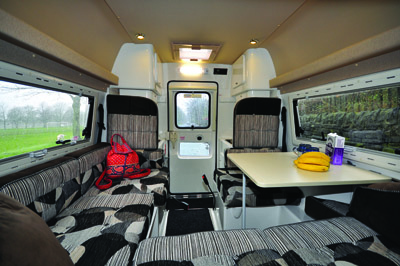
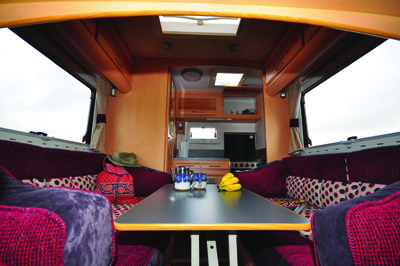
COOK’S QUARTERS
In small motorhomes you expect compromises in the kitchen, but the Nu Surf excels – the little end galley providing more facilities than many full-sized ’vans. Work surface is lacking, but even that is provided, to some extent, by a full-sized, stainless steel sink (with drainer), which has a mixer tap and tinted glass lid. There’s a four-burner hob (electronically-ignited), with grill below and a 60-litre three-way fridge with small freezer compartment.
The R20’s rear door necessitates a divided kitchen. There’s only room for a two-burner hob, but this also has electronic ignition. In production, there will be a grill underneath and from photos seen, it looks very smart. Below is the same Dometic 60-litre fridge as used by Nu Venture – great minds thinking alike.
Opposite is the sink, with glass lid and internal mixer tap. There’s no room for a drainer, but on both sides of the kitchen (as previously mentioned), a flat work-surface is provided by dropping forward the headrests of the travel seats.
Overall, and though they are very different, both ’vans provide much better kitchens than you’d have any right to expect in such compact motorhomes.
BATHING
On the R20 tested there was no washroom. You could store a Porta Potti-type toilet in the large drawer under the centre of the rear-facing settee, but I suspect most will opt for the option of the tip-up sink with toilet below.
The Nu Surf, however, has a proper washroom – small, simple and perfectly formed. There’s a Thetford C200 swivel-bowl loo (dedicated flush-water supply), with sufficient knee and elbow-room, and a drop-down washbasin opposite. It even has
a blown-air heating outlet.
BEDTIME
The Nu Surf’s bed-making procedure is as follows: for a short transverse double, slide out the offside (slatted) seat base to rest on the nearside base – easily done. Backrest cushions partially fill the resultant gap on the offside and a further pair of strip infills, (stored in the overcab), are squashed in.
The R20 bed-making is rather more complex, largely because of the sheer number of cushions: we counted 14. There’s only room in there for one person when bed-making, so I went for a walk. Thankfully, Rona enjoys puzzles!
A transverse double is available (given proper support), but is rather Hobbit-sized,
at 1.75m (5ft 9in) long. And that previously mentioned ‘cup holder’, moulded from cold, hard GRP, reduces width at the foot to a measly 820mm (2ft 8.5in).
Alternative longitudinal singles have better length, at around 1.91m (6ft 3in) each, and the offside bed is an acceptable, if modest, 610mm (2ft 0in) wide. However, although the nearside bed is nominally slightly wider, that dratted cup holder reduces usable width to 560mm (1ft 10in) at shoulder level, where humans are widest. You could try sleeping with your head in the cab, but you’d then rub knees with the cup holder.
STORE ROOM
Remember that low maximum weight of 2,240kg? Both manufacturers have worked wonders, achieving payloads of 360kg or thereabouts – ample, given the size of motorhome, and even more praiseworthy taking their (standard-fit) spare wheels into account.
Both have good cab storage, with a slim overhead shelf (for my hat and her map-book) and a large removable bin between the seats, plus loads of cubbies.
In the Nu Surf, you store bedding and some clothing in the huge overcab cupboard, along with the table and extra bed cushions. There are two overhead lockers on each side of the lounge and plenty of space under each settee, with drop-down front flaps and lifting seat bases – it’s a pity they lack stays.
The R20 has a similar, but slightly smaller overcab. Unfortunately, on the test, it was full of extra bedding cushions. When living with this ’van, you’d quickly deduce which could be left at home.
LIFE SUPPORT
As standard, the R20 comes without space heating, though a diesel-powered unit is optional. Nu Venture fits a Truma gas-fired space heater with two blown-air outlets as standard.
The Nu Surf has room for two 7kg gas bottles, but the R20 makes do with one 3.9kg cylinder. We were surprised by Romahome’s tiny, 23-litre inboard freshwater tank, which was dwarfed by the 70-litre tank fitted underneath the Nu Surf. Both motorhomes had sensible control panels adjacent to their caravan doors.
CONCLUSION
We felt the sleeping arrangements in the Romahome needed modification and we are confident the end result will be worthwhile. Nu Venture’s Nu Surf proved to be much more the finished product, and offers quite remarkable value for the money. Starting at £30,650, there’s hardly anything on the market to compete for those wanting a miniature, well-equipped motorhome. And if you’d prefer a rear-panel-located caravan door, Nu Surf RD is available at the same price.
This is an edited version of a longer article which appeared in the April issue of MMM. To download a digital edition of MMM, click here.
Expert motorhome advice to your door!
Why not subscribe to one of our fabulous magazines and get expert advice, travel ideas, technical help and all the latest news for your motorhome and your motorhome adventures!
Want to know more about MMM magazine?
Every month MMM has articles written by motorhomers who have been there and done it, from great UK and European (and further afield) tours, campsite reviews, owners' reports and DIY projects among other things. MMM's tests, reviews and expert buying guides are not to be missed. MMM's technical advice is a must and includes everything from weekend jobs to longer-term DIY projects. And much more!
About MMM magazineWant to know more about What Motorhome magazine?
Every issue of What Motorhome magazine provides essential buying advice for anyone looking to buy a new motorhome or campervan or upgrade their existing model. With a pedigree of over 30 years of offering the best motorhome and campervan buying advice, every issue of What Motorhome includes more new motorhome and campervan reviews than you will find in any other magazine.
About What MotorhomeWant to know more about Campervan magazine?
Campervan is the exciting monthly magazine that will give you all the inspiration you need to explore the world in your campervan. Every issue is packed with real-life campervanning experiences, inspiring travel ideas in the UK and further afield, the best campsites to stay on, campervan road tests and reviews of the latest models, and much more!
About Campervan magazine

